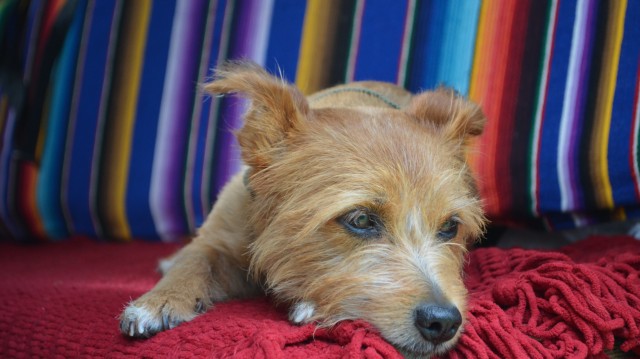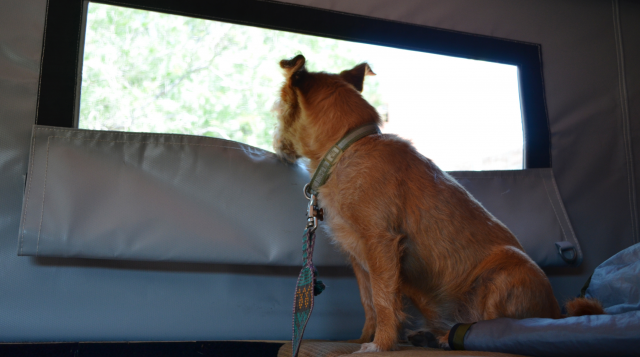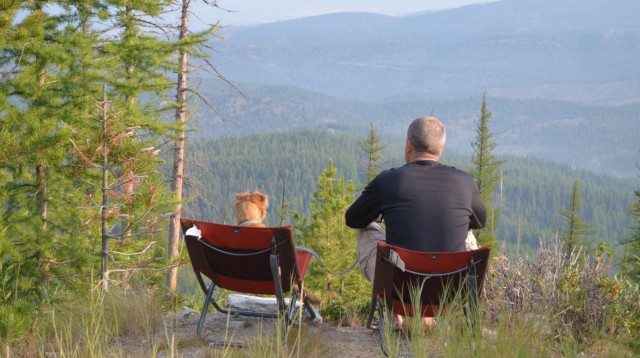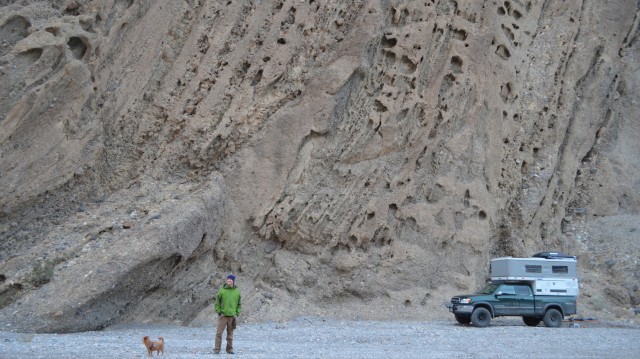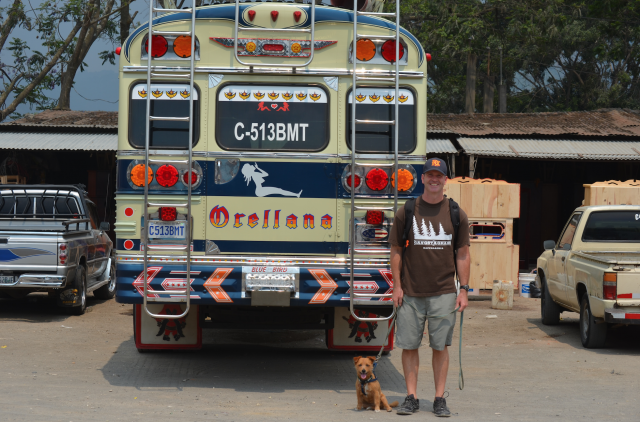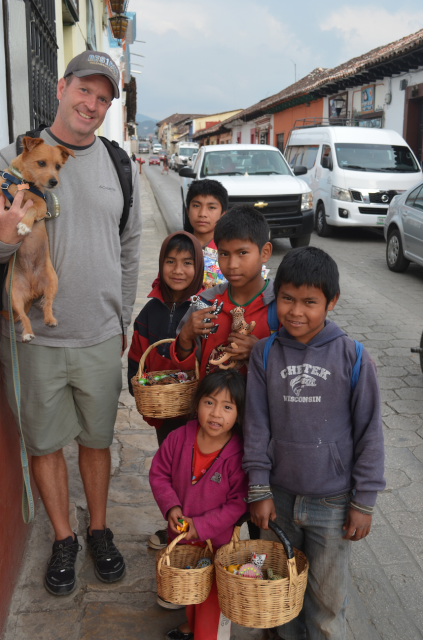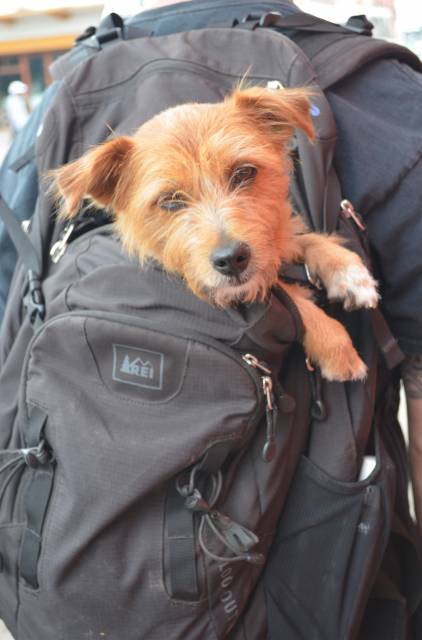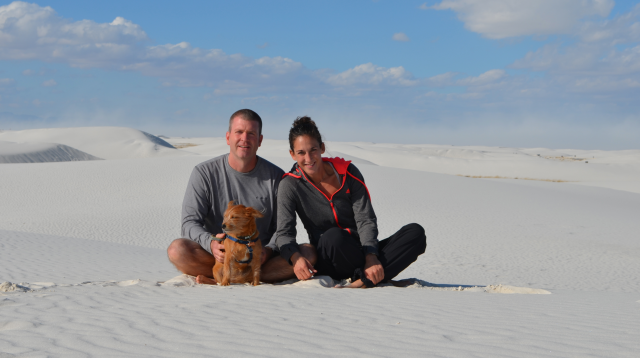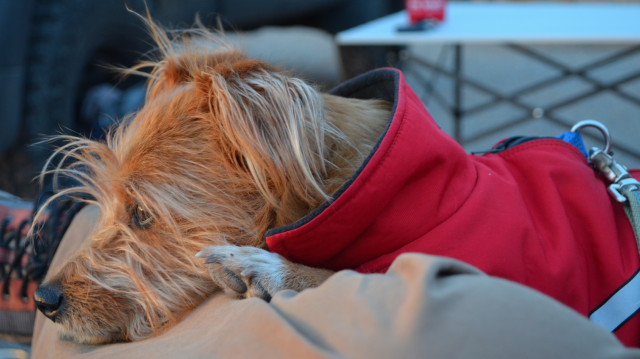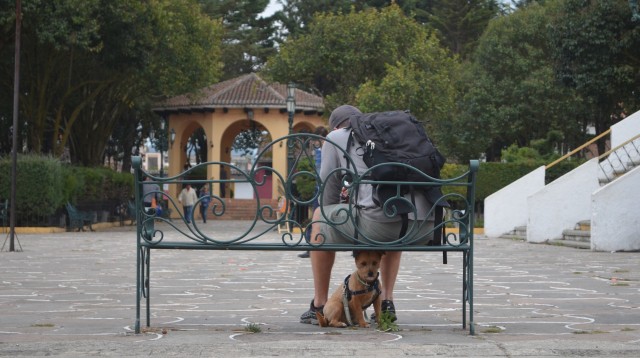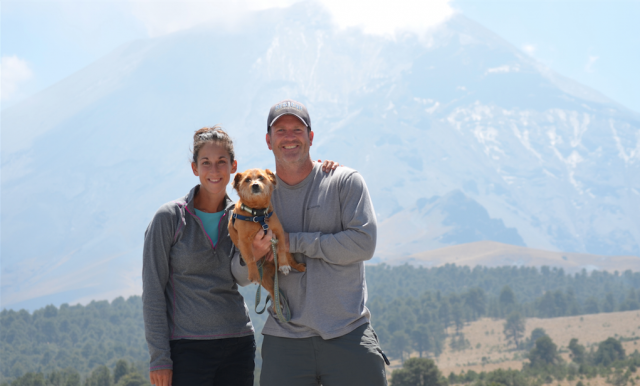I wake up to something pushing against my face. A tap followed by another tap, followed by something wet on my lips. As my eyes flutter open and the light of day brings life to the shapes around me, I see her. Her brown eyes are staring directly into my own, another lick on the nose and she is not willing to wait another second. This dog is ready to head outside for her morning routine. Her wiry brown body is sitting up at attention and needing mine. I roll over and look at my husband who pretends to still be asleep, but his eyes are pressed together too tightly. I know better and I just lost the game of “whoever makes eye contact with the dog first, takes her outside.” I am taking her out.
She makes the leap from the bed down to the couch and sits in front of her leash, tail whipping from one side to the other, patiently waiting. I notice her food bowl containing a few pieces left over from last night. Her water dish is full. She has a dedicated spot on the couch, on the floor, on the bed. In a camper only big enough for two, she has managed to claim a lot of space. I can’t help but think how far away this life is from the street we found her on in Washington DC. A dirty, thin dog growling with a chicken bone clenched tightly between her teeth. She had a tag and a name, Sprite. But the look on the owner’s face when Sprite was returned should have given us a warning. This dog was trouble. The owner’s plans were to take her to the pound, so we gave a shoulder shrug and thought, how much trouble can 15 lbs be? A few hours into the relationship Sprite’s personality sprang out like her energy that bounced on every piece of furniture in our house. Our veterinarian calls her a terrorist instead of a terrier, and we all get a good laugh when they pull out the “party hat” (muzzle) when it’s time for vaccinations.
This is a dog that does not like other dogs, she does not like people trying to touch her until she has given them the sign (which involves a routine and not everyone passes), she has been through a handful of dog trainers and comes out the exactly the same dog she was going in. Nothing changes. 8 years later and we can’t imagine our life without this scraggly mutt, who growled her way into our hearts and onto her perch that sits behind the driver’s seat of our truck, on the top of piles of bags and tools and a few old blankets. She sits there and monitors the world from her throne. She barks when anyone gets too close, she throws herself at the window when we pass cows in fields or horses riding by on the street. She feels that 15lbs aint nothing but a number and no excuse to not dominate anything that moves. There is another side to her. A not so crazy, very lovable, cuddly dog. Who just so happens to love overland travel. When it’s time to pack up and roll to the next place she gets so excited that her leash becomes a live snake that must be killed before returning to her throne. Once the snake is dead she bolts for the driver’s side of the truck, sits in perfect form and waits for a boost. She can sleep on almost anything – upside down, on uncomfortable surfaces, between our plastic clothes drawers, once on a few avocados, or on the passenger’s side mat tucking herself near the vent (on warmer days she goes for this spot and stares at me until I turn on the AC – this dog is no dummy). During colder months we tuck her into our sleeping bag where she bundles in and provides heat throughout the night. When a hike is too long she jumps for the backpack and we actually carry her. We plop her in and zip up to her neck, where she sits with an expression that is of comfort and satisfaction…this is normal right?
What is it about a dog? They fill up the cracks and the empty spaces of our families with a different kind of love. A love that makes us question their safety and health when deciding to hit the road to travel for an extended period of time. We asked ourselves this question and we get a lot of other overlander’s asking it too: What do we do with our dog? Do we leave them behind? What are the risks of taking them with us?
Sprite has been along for weekend camping trips, to a number of overland cross-country trips, and recently she has crossed borders from Mexico and every country in Central America. It is never an easy decision, because there are so many factors. But this is true of any kind of trip: a solo journey will be different than being with a few close friends. The rig you drive and where you go will change the trip from someone else driving something different. Bringing a dog will absolutely change your trip. There have been moments where my husband and I are in the camper fuming and stressed about Sprite. There are moments when we felt like bad parents, such as when Sprite had a chunk of her ear ripped off by a camp host’s dog in Mexico. There are more moments like in the morning, when she is energized and ready to face the day. When the military wants to search the truck but meets Sprite on her perch with an outburst of barking and sends us on our way. When she alerts us at night if something or someone is lurking. It’s a pile tangled up with several elements and sifting out the right decision can only be done by you. From the viewpoint of the perch where Sprite sits, here are some things to consider.
Your dog’s personality
How does he/she do on the road? Long trips? Some dogs get stressed if their routine is not what they are used to. Getting car sick. This is one area we got very lucky. Sprite can fit anywhere and likes to go everywhere. She has been on 12+ hour long driving days and once an 18 hour ferry ride. As long as she can jump out to stretch her legs (just like we need to do ) she’s happy.
Consider the environment
Sprite has picked up ticks in every country from the US to Mexico to Panama. At times we have flipped her over while I work the tweezers to pluck plump ticks from her skin. In Costa Rica she had over forty at one point. One solution would be to have a stash of tick juice (Frontline works really well). We ran out in Mexico and could not find more. Plan ahead and pack enough for the length of your trip. We also recommend discussing this with your vet. Our friend’s dog got very sick from ticks even while using Frontline.
To leash or not leash
This has been a topic of hot debate. Lots of folks love to see their dogs running free. A dog not on a leash is a dog that can do several things: Eat anything on the ground including poisonous pieces of who knows what. Get attacked by other dogs. Jump on someone’s vehicle leaving the worst scratches picked up in over 15,000 miles. (This happened to us. A couple of overlanders had their dogs running up to every vehicle – they were not leashed and both jumped up and scratched the side of the door on their way down). Leashing a dog limits their freedom, but also ensures their safety. You can’t control who will walk up to your dog, what another dog will do, but you can control your own. Not everyone thinks your dog is cute.
Sightseeing, Restaurants, Camping & Hotels
There are places that dogs are absolutely not allowed to go that you will want to see or places you will want to stay. Most of the National Parks in the US will not allow dogs on any of the trails (although they are allowed in the camping areas). Costa Rica has a no pet policy for their National Parks. Tikal (Guatemala), Palenque (Mexico), Copan (Honduras) – nope. There are several private campgrounds that do not allow dogs. A favorite of many, Overlander Oasis in Oaxaca Mexico, recently changed their policy because of irresponsible dog owners. We deal with this by getting creative and being flexible…this is after all an adventure. Look for areas right outside the places you want to go. For example, in the US the National Forests allow pets everywhere–there are some right outside many of the National Parks that are not as busy and very beautiful.
Take turns. During our time at Palenque, I spent the day at the ruins while Colin hung back at the campground and then he went the next day. We left Sprite in the camper on a cooler day in Monteverde in Costa Rica, with a camp host on site. We felt Sprite was safe, it wasn’t hot in the camper and we were able to walk to the cloud forest.
We have been lucky with a lot restaurants in Mexico and Central America. Of course, this depends on what kind of places you are looking for. We like causal. Casual places usually say “no problem” when we ask if Sprite can come in. Look for patios. We have never been turned down when we ask if we can sit on the patio. Street vendors and markets are the places you should NOT miss and dogs are everywhere!
Leaving your dog in the car/camper/rig
Really put some thought into this decision. We have wanted to quickly hit the grocery store and considered leaving Sprite in the truck, but we stopped and thought for a second and you should too. This is when most break-ins happen. We met a couple of overlanders who did this exact thing and came out with their dog still in the car but stuff gone and the door left wide open. Just because the dog is there doesn’t mean someone won’t take the opportunity. There are plenty of campgrounds and parking lots with security and places that feel safe – make sure they are. Ask the security guard, talk to the campground owners or other campers. If you do decide to leave, make sure the weather is not going to leave your pup panting and praying for your return. It can get hot!
Food
Finding food is very easy as long as your dog does not have a special diet. There are big grocery stores and pet food stores…and Walmart. The brands we love in the US we could not find in Mexico and Central America. The popular brands you can find easily are Pedigree, Alpo and Purina. If that doesn’t sit well your dog’s tummy, then be prepared to cook.
Vaccinations & Borders
Right before we crossed into Mexico we made an appointment with a veterinarian in San Diego, California to get Sprite her IHC (International Health Certificate). We have been asked for this document while crossing almost every border (and very happy to have a stack of copies in our folder to hand over so we can keep the original). See link below for the list of necessary vaccinations and current check ups your dog will need.
This dog. She is part of our team and more importantly our family. She has taught us a lot about patience and the meaning behind adventure. She is also a wonderful topic of conversation. We have had more kids and adults walk over to enquire about this little mutt. They want to know her name and laugh when they realize it’s the same as the popular drink. They are curious about her age and breed…and then surprised and step back when we say “muerde or bravo”. We get a lot of pointing and giggles when she ends up in the backpack. This dog. I catch myself watching her as we drive. The windows down, her nose in the air taking in new smells, watching landscapes flash by, her tail curled up. She wouldn’t have it any other way…we wouldn’t either.
Read more of Sprite’s travels by clicking the banner below:



